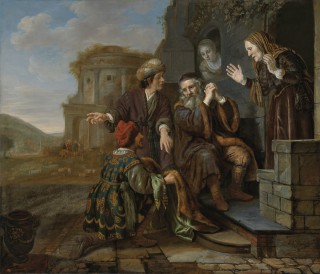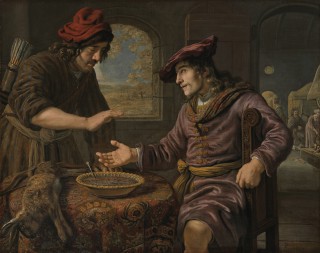Joseph’s Bloodied Coat is Shown to Jacob
- Date
- 1649
- Object type
- painting
- Technique
- oil
- Material
- canvas
- Dimensions
- 96,9 x 112,9 cm
- Acquisition date
- 1764
- Location
- The Palace on the Isle - Portrait Room, ground floor
- Marks and inscriptions
- signed and dated Jan. Victors./ 1649., bottom right red number 75 of the Stanisław August collection, bottom left
- Place of Origin
- Amsterdam (Netherlands)
- Owner
- The Royal Łazienki
- Museum number
- ŁKr 927
Genesis 37: 22–23. …
Religious paintings constitute a major part of Victors’ oeuvre. The artist only painted scenes from the Old Testament, which distinguishes him among contemporary Dutch artists, who, as protestants, did not altogether abandon painting Christological subjects, although they painted Old Testament themes more frequently. According to Debra Miller, the reason for such an approach should be sought in Victors’ orthodox Calvinism, which is why he remained strictly within the rules for the veneration of religious images (D. Miller, Jan Victors 1619–76, diss., University of Delaware 1985, pp. 164–166) . The painter was more interested in the underlying didactic meaning of his compositions than in their artistic merits; in this respect he was like Pieter Lastman who, along with Rembrandt and Govert Flinck, had perhaps the greatest influence on his work. Victors’ idea was that his Old Testament paintings were to be an interpretation of the biblical content that was as accurate as possible. The gestures of the protagonists in his paintings are expressive, yet ‘suspended’—thus clearly illustrating the event and highlighting the dramatic tension. The rhetorical language of the gestures, often borrowed from theoretical writings, was consciously used by the artist to express a variety of emotions; as Debra Miller wrote ‘Victors’ paintings suggest that he was an enthusiastic practitioner of the art of manual rhetoric’ … . In the Łazienki painting, Jacob raises his hands upwards in a characteristic gesture of deep despair and mourning; in Debra Miller’s opinion, the direct inspiration for Victors was Rembrandt’s representation of the same scene from 1633 … . [D. Juszczak, H. Małachowicz, The Stanisław August Collection of Paintings at the Royal Łazienki. Catalogue, Royal Łazienki Museum, Warsaw 2016, no. 111, pp. 406–408.]








